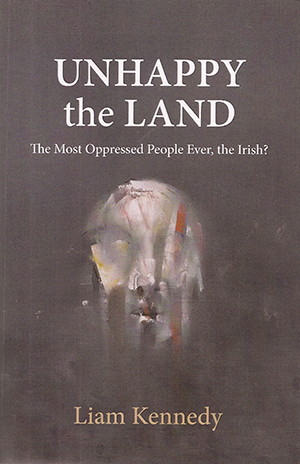Unhappy the land: the most oppressed people ever, the Irish?
Published in Book Reviews, Issue 4 (July/August 2016), Reviews, Volume 24LIAM KENNEDY
Merrion Press
€22.50
ISBN 9781785370281
Reviewed by: Fearghal Mac Bhloscaidh

This collection of nine essays deals with Irish history across three periods. The first three provide the long view: ‘A Most Oppressed People?’, ‘The Planter and the Gael’ and ‘Nationalism and Unionism in Ireland’. The framework of the latter chapter, Kennedy himself admits, is ‘inadequate’ (p. 217). The second part contains two essays on the Famine: one dismissing comparisons to the Holocaust and another attacking Irish-American claims of genocide. The collection concludes with four essays on the revolutionary period: individual assessments of the 1912 Ulster Covenant (‘harbinger of reaction’) and the 1916 Proclamation (‘bad blood’) are followed by a comparison of both entitled ‘texting terror’ (this is in effect one extended piece), while Kennedy ends by asking: ‘was there an Irish war of independence?’
The first chapterestablishes the MOPE (Most Oppressed People Ever) concept, a straw-man argument that the Irish view their past as ‘uniquely painful’. Thenineteenth-century nationalist speeches employed to establish this argument pre-date much of theevidence employed to refute it. Nevertheless, in 1874Disraeli conceded that Ireland was ‘governed by laws of coercion and stringent severity that do not exist in any other quarter of the globe’. Similarly, by the early twentiethcentury Irish radical opinionexpressed solidarity for oppressed people, made no such claims to a unique status of suffering and fully acknowledged Ireland’s favourable treatment compared to the Hindus and Hottentots.
‘The Planter and the Gael’ argues that over a 300-year span significant interaction took place between the native and colonist populations.In societies with far more noticeable racial signifiers, laws against miscegenation indicated that plenty did. Evidence for Protestant planters converting to Catholicismrelies onthe analysis of three surnames in the 1911 census, with the main focus on Bell. Kennedy ignores the Gaelic Mac Giolla Mhaoil orthe Norman de Beil. The surnames are broken down by province and then presented as percentages. Ten minutes’ research on-line provided these figures for Bell: Ulster 6,141, Leinster 985, Munster 155 and Connacht 125.In reality, the actual figures point towards the resilience of religious persuasion as an ethnic marker in Ulster (the only representative sample), where a cross-class colonial-settler population existed.
Kennedy then includes two chapters on the Irish Famine.The first refutes comparisons with the Holocaust by summarising Irish historiography. Kennedy then gravely remarks how ‘Irish Famine genocide’ received 465,000 hits on Google, while ‘Irish Famine Holocaust’ received onethird of a million. ‘These are truly astonishing figures, even if many of the results are only incidentally relevant’ (p. 83). Indeed, this reviewer’s search for ‘French Revolution Holocaust’ received 521,000,‘Crimean War Holocaust’621,000 and, despite only incidental relevance, ‘banana milkshake Holocaust’ received 2,680,000. For an emeritus professor, apparently ignorant of the workings of internet search engines, to employ such as‘historical’ evidence represents ‘a most curious enterprise’ (p. 117).
Kennedy concludes that‘true enough there were condescending references to the Celtic temperament’, but this bore ‘little resemblance to the anti-Semitism coursing through German society a century later’ (p. 88). Evidence of this anti-Semitism is restricted to colourful quotes from Hitler. Christopher Browning’s excellent functionalist analysis is reduced to a caricature to serve an argument more akin to his historical opponentDaniel Goldhagen (p. 92). Of the over 100 references, seven relate to Holocaust studies. Kennedy has no interestin the Shoah except as a black-and-white horror story (p. 93).He concludes that British Whig politicians ‘were not misanthropic monsters but well-intentioned individuals on the whole’. Ironically, Browning’s Ordinary men(1992)demonstrated that police battalion 101 did not conform to the grotesque Nazi caricature on which this false comparison rests.
The third section, on the revolutionary period, exposes this collection as a crude ideological assault posing as history. While Kennedy treats the Covenant with kid gloves, his assessment of the 1916 Proclamation verges on the irrational. During the Rising, romantic nationalist ‘storm troopers’seized Dublin’s monuments in a similar fashion to 9/11 when, ‘in another moment of ecstasy’, Al Qaeda attacked the Twin Towers (p. 174). Elsewhere, and with Mac Piarais and Casement as totems, Kennedy employs his full Freudian lexicon to portray the Rising as a proto-fascist paedophile ring (p. 165). While there is no indisputable evidence regarding either’s proclivity for sex with minors, an abundance exists for their principled opposition to imperialism.
Untypically, Kennedy avoids statistics in the final chapter. The actual figures for fatalities disprove his thesisof an equivalence of sectarian violence north and south or that the IRA primarily directed its campaign against civilians. Civilians made up about 15% of the 1,400 fatalities in the 26 counties prior to July 1921. The figure for the sixcounties between July 1920 and 1922 was90% of approximately 550. Kennedy’s argument that the IRA unleashed a ‘reign of terror’ against Protestants uncritically accepts Peter Hart’s problematic analysis of the Dunmanway killings in April 1922 and then proceeds ‘to take a single example, chosen more or less at random’, to reinforce the point (p. 206). He then draws on retrospective oral testimony from Templederry, Co. Tipperary, to strengthen the sectarian thesis, admitting, in a footnote, that the communities actually ‘got on well’ (p. 261).
Overall, Kennedy has contributed little to our understanding; the reasoning is porous and inconsistent, the tone is manic, the historical value negligible.
Fearghal Mac Bhloscaidh is the author of The Irish Revolution: Tyrone 1912–23 (Four Courts Press, 2014).
















